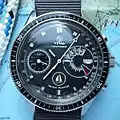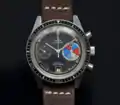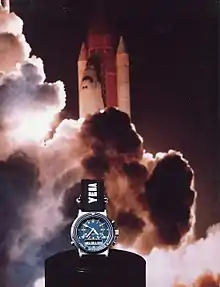Yema (watch)
Yema is a French watchmaking company based in Besançon, France. Founded in 1948 in Besançon (Doubs) by Henry Louis Belmont.
 | |
| Industry | Watch manufacturing |
|---|---|
| Founded | 1948 |
| Founder | Henry Louis Belmont |
| Headquarters | , |
| Products | Wristwatches, accessories |
| Owner | Yema |
| Website | https://en.yema.com/ |
History
The evolution of the brand is punctuated by:
- The anti-shock watch in the 1950s;
- The Yema Superman waterproof to 300 meters in 1963;
- The Yema Rallygraf equipped with a tachometer for car enthusiasts in 1968;
- The Yema Spationaute first French watch to fly in space with Jean-Loup Chretien in 1982;
- The Yema North Pole which accompanied Nicolas Hulot and Hubert de Chevigny in the exploit of the North Pole in 1987.
In 1966, 1967 and 1968 Yema becomes the leading exporter of French watches with more than 500,000 watches sold every year across 50 countries.
In 1982 Henry Louis Belmont's son sells the brand to Matra (Groupe Lagardère) which in partnership with Thomson takes control of Yema. At that time the brand produced 2 million watches per year.
Having been owned by Seiko Watch Corporation of Japan since 1988, Yema returns to French hands in 2004 through a buyout by Louis Eric Beckensteiner.
In 2009 Yema is acquired by the French watchmaker group Montres Ambre based in Morteau.
 Yema original logo
Yema original logo Yema factory, 1961 Besançon (France)
Yema factory, 1961 Besançon (France)
1948 - Henry Louis Belmont
Henry Louis Belmont, student of the National Watchmaking School of Besançon and major of his promotion in 1931, created 1948 his own watchmaking company under the name Yema.

1963 - Yema Superman collection
In 1963 Yema launches the very first Yema Superman, a watch initially developed for diving professionals.
Many variations were then produced by Yema for this model of French manufacture in order to reach a wider audience, as for example the famous 53.00.16 and its black dial or the 24.11.17 with its blue Iridescent dial and its second hand "Pelle".
 Yema Superman 1963
Yema Superman 1963.jpg.webp) Yema Superman 1963
Yema Superman 1963 Yema Superman 1963
Yema Superman 1963 Yema 1960 collection
Yema 1960 collection Yema collection 1963
Yema collection 1963
1966 - Yema Yachtingraf collection
In 1966, the first Yema Yachtingraf is launched, a watch especially designed for sailors. This automatic chronograph (Valjoux movement), waterproof to 200 meters, was very popular among French yachting amateurs in the 1960s and the 1970s.
Start of 1970 Yema became official supplier of the French Sailing Federation (Fédération Française de Yachting à Voile) and equipped the French National team who participated to 1972 Olympic Games.
Six different versions of Yema Yachtingraf model were crafted over the years.
 Yema Yachtingraf 1970
Yema Yachtingraf 1970 Yema Yachtingraf Regate 1970
Yema Yachtingraf Regate 1970 Yema Yachtingraf Croisiere 1966
Yema Yachtingraf Croisiere 1966 Yema Yachtingraf 1967
Yema Yachtingraf 1967 Yema Yachtingraf patent 1969
Yema Yachtingraf patent 1969
1966 - Yema RallyGraf collection
The first Yema Rallygraf model was also born in 1966, a watch appreciated by car racing amateurs. One of these chronographs was worn by Formula One Champion Mario Andretti.
 Yema Rallygraf 1966
Yema Rallygraf 1966 Yema Rallygraf 1970
Yema Rallygraf 1970
1982 - First French Watch in Space
On June 24, 1982, for the first time a French astronaut, Jean-Loup Chrétien, flew from the Baikonour base for a 10-day trip into space. On his wrist he wears the very first French watch to leave for the space: the Yema Spationaute I.
On June 17, 1985, the Discovery shuttle took off with Patrick Baudry and his Yema Spationaute II on mission STS-51G (First Franco-American Orbital Flight).
On November 26, 1988, Jean Loup Chrétien goes on a mission to MIR Space Station wearing a Yema Spationaute III.

1986 - North Pole Mission
In May 1986, Yema joined forces with French physician and explorator Jean-Louis Etienne to cross the North Pole. The Yema North Pole watch, created especially for the occasion, accompanied the adventurer during his 800 km solo trip to the North Pole. Very resistant to cold thanks to its titanium case, this model also had a system avoiding the magnetic north. The four cardinal points were determined according to the position of the sun, with the local sun's time as a reference point.
2009 - Innovative watch movement
After 4 years of research & development, Yema designs a new proprietary watch movement: the MBP 1000. Equipped with a bidirectional oscillating mass mounted on ball bearings, they allow a fast reassembly and a power reserve of 40 hours. This resulted in a gain of efficiency but also precision, provided by a regulator whose balance beats at a frequency of 28,800 alternations per hour. Stacking a total of 31 rubies including 2 located at the ends of the axis of the barrel, this technical design effectively reduces the friction generally observed at this element following the mechanical movements.
2017 - Proxima Mission
The mission on which the 10th French astronaut went into the space was called Proxima, in tribute to the nearest star of our sun, which perpetuates the French tradition of baptising the missions of astronauts by the name of a star or a constellation. In 2017, Yema and CNES (the French Space Agency) worked once again together to create a brand new model in honour of this new space mission, the Yema Spacegraf.
External links
- Yema official website (English)
- Page commemorating the 60 Years of Yema (French)
- Press article (Le Monde) commemorating the 60th Yema anniversary (French)
- Opinion article on Yema's history and 2017 new collection (French)
- Overview of sailing regatta watches: Yema Yachtingraf (English)
- Yema Yachtingraf - The Compendium (English)
- The history of Yema explained by a vintage watches amateur (French)
- Yema's history on Watch-Wiki (German)